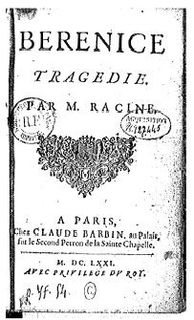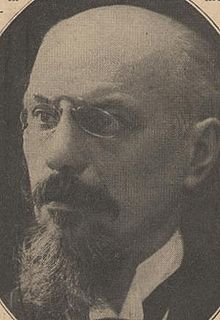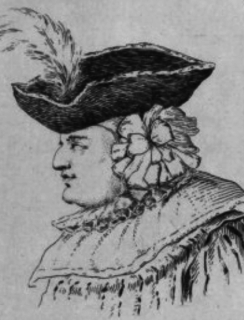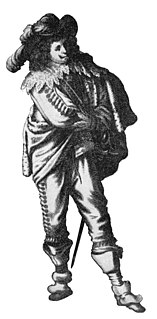
Berenice is a five-act tragedy by the French 17th-century playwright Jean Racine. Berenice was not played often between the 17th and the 20th centuries. Today it is one of Racine's more popular plays, after Phèdre, Andromaque and Britannicus.

Tite et Bérénice is a heroic comedy by the 17th-century French playwright Pierre Corneille.

Le Cid is a five-act French tragicomedy written by Pierre Corneille, first performed in December 1636 at the Théâtre du Marais in Paris and published the same year. It is based on Guillén de Castro's play Las Mocedades del Cid. Castro's play in turn is based on the legend of El Cid.
Jean Rotrou was a French poet and tragedian.
George Dandin ou le Mari confondu is a French comedy by Molière. It premiered on 18 July 1668 at the Palace of Versailles. Subsequent public performances were given in the theatre of the Palais-Royal beginning on 9 November 1668.

Émile Fabre was a French playwright and general administrator of the Comédie-Française from 2 December 1915 to 15 October 1936. He was greatly influenced by Balzac as a young man, and most of his best-known plays deal with the sacrifice of personal happiness to the pursuit of wealth. He also wrote the libretto for Xavier Leroux's opera Les cadeaux de Noël which was a great success when it premiered in Paris in 1915.
The Liar is a farcical play by Pierre Corneille that was first performed in 1644. It was based on La Verdad Sospechosa by the Spanish-American playwright Juan Ruíz de Alarcón, which was published in 1634.

Antoine Laurent Apollinaire Fée was a French botanist who was born in Ardentes, 7 November 1789, and died in Paris on 21 May 1874. He was the author of works on botany and mycology, practical and historical pharmacology, Darwinism, and his experiences in several regions of Europe.

Hôtel de Bourgogne was the name of a former theatre, built in 1548 for the first authorized theatre troupe in Paris, the Confrérie de la Passion. It was located on the rue Mauconseil, on a site that had been part of the residence of the Dukes of Burgundy. The most important French theatre until the 1630s, it continued to be used until 1783.
La Thébaïde, or The Thebaid, is a tragedy in five acts in verse by Jean Racine first presented, without much success, on June 20, 1664 at the Palais-Royal in Paris. The play depicts the struggle and death of the young son of Oedipus, as well as that of Antigone. This subject had already occupied many authors before Racine. Thus, the young playwright, still fairly inexperienced, drew particularly from the Antigone of Sophocles, the Phoenician Women of Euripides, but especially the Antigone of Jean Rotrou and the tragedies of Pierre Corneille.

Les Plaideurs, or The Litigants, written in 1668 and published in 1669, is a comedy in three acts with respectively 8, 14, and 4 scenes in alexandrine verse by Jean Racine. It is the only comedy he wrote. It was inspired by The Wasps by Aristophanes, but Racine removed all political significance. His play, which he wrote after Andromaque and before Britannicus, was a farce that was unexpected in his work amongst the tragedies.

Andromède (Andromeda) is a French verse play in a prologue and five acts by Pierre Corneille, first performed on 1 February 1650 by the Troupe Royale de l'Hôtel de Bourgogne at the Théâtre Royal de Bourbon in Paris. The story is taken from Books IV and V of Ovid's Metamorphoses and concerns the transformation of Perseus and Andromeda. The play has rarely been revived and is mostly remembered today for the set of six engravings by François Chauveau depicting the elaborate Baroque set designs of Giacomo Torelli.

The Théâtre de l'Athénée is a theatre at 7 rue Boudreau, in the 9th arrondissement of Paris. Renovated in 1996 and classified a historical monument, the Athénée inherits an artistic tradition marked by the figure of Louis Jouvet who directed the theatre from 1934 to 1951. During the period when he was director, it became known as the Athenée Théâtre Louis-Jouvet.

The Théâtre du Palais-Royal on the rue Saint-Honoré in Paris was a theatre in the east wing of the Palais-Royal, which opened on 14 January 1641 with a performance of Jean Desmarets' tragicomedy Mirame. The theatre was used by the troupe of Molière from 1660 to 1673 and as an opera house by the Académie Royale de Musique from 1673 to 1763, when it was destroyed by fire. It was rebuilt and reopened in 1770, but again was destroyed by fire in 1781 and not rebuilt.
La Galerie du Palais is a 1632 comedy by Pierre Corneille. The comedy concerns the love relationships of two couples: Lysandre and Celidee; and Dorimant and Hippolyte.

The Théâtre Historique, a former Parisian theatre located on the boulevard du Temple, was built in 1846 for the French novelist and dramatist Alexandre Dumas. Plays adapted by Dumas from his historical novels were mostly performed, and, although the theatre survived the 1848 Revolution, it suffered increasing financial difficulty and closed at the end of 1850. In September 1851 the building was taken over by the Opéra National and renamed again in 1852 to Théâtre Lyrique. In 1863, during Haussmann's renovation of Paris, it was demolished to make way for the Place de la République. The name Théâtre Historique was revived by some other companies in the late 1870s and early 1890s.

François Le Noir, sieur de La Thorillière was a French comic actor, who was born and died in Paris.

Montdory, pseudonym of Guillaume des Gilberts, was a French actor manager, recognized as "the most powerful tragedian of his day."

Charles Le Noir or Lenoir was a French actor-manager, who was a member of the troupe of the Prince of Orange from at least 1622, sometimes named as a co-founder with the actor Montdory of the Théâtre du Marais in 1634, and a member of the Troupe Royale at the Hôtel de Bourgogne from 1634 to 1637.

















